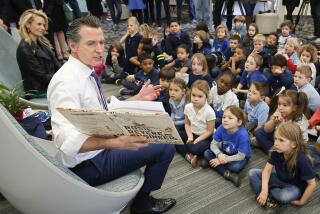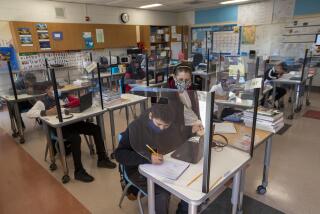Bilingual Education
- Share via
* Re “Breaking the Language Barrier,” Jan. 12.
The author writes: “With our arms full of my junk, we passed one another on the driveway many times. . . . But we never spoke. Neither of us could speak the other’s language.”
How shameful that this writer assumed that this Mexican worker could not learn. How sad that the writer did not take the time to stop the worker and describe an article being moved. For example, “Jorge, this is a lamp.” By day’s end, this worker could have learned many new English words. Perhaps the writer was more concerned with the cost of increasing the laborer’s time to move him into the new house.
My parents, my brother and sisters are thankful that Americans taught us the English language. No American thought we had to be taught in our language. No American ever thought we were too ignorant to learn. Thank you, America.
FRANCIS JANSEN
Northridge
*
* Yes, indeed, bilingual education for Spanish, English and all students will better prepare them for today’s world.
Many people are probably unaware that there are three goals for bilingual education: English oral language proficiency, academic achievement and psychosocial development (positive self-concept, including pride in one’s culture, language and family values).
Educational research shows that having a strong foundation in the primary language actually enhances later English language development and proficiency.
In addition, bilingual education allows young children with limited English proficiency to achieve more academically than they could in an English-only program. Bilingual education also provides students with structured learning opportunities to promote cross-cultural awareness and more positive self-concepts, which increase students’ motivation and interest in doing well in school.
All children deserve a fair chance to compete in the marketplace. That’s exactly the purpose of bilingual education. Bilingual adults enter the marketplace with major advantages because of their ability to communicate in more than one language.
PAMELA BAILIS
Los Angeles
Bailis is co-director of the Teacher Education Program at UCLA Graduate School of Education & Information Studies.
*
* Hymon is obviously not a teacher with the Los Angeles Unified School District or he would not have been so easily bamboozled by the educratise the district uses to define “bilingual” education. Has Hymon seen the Spanish-language textbooks--for social studies, math, science, all the academic subjects--that thousands of Hispanic students use in LAUSD throughout their early years? When native English speakers use English-language texts, does Hymon call that learning Spanish?
DOUGLAS LASKEN
Woodland Hills
More to Read
Sign up for Essential California
The most important California stories and recommendations in your inbox every morning.
You may occasionally receive promotional content from the Los Angeles Times.










